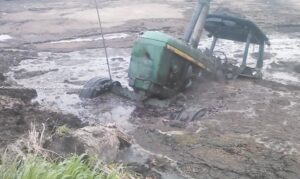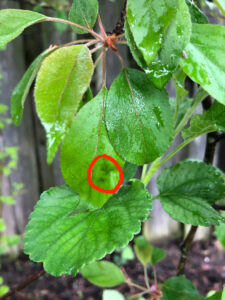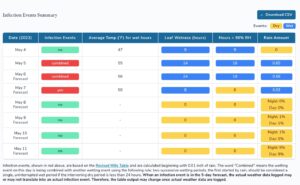Indiana seems to experience the entirety of US weather, sometimes in the same day. The recent spate of cool, wet weather has left apple scab one happy fungus (Fig. 1). Most of the state just underwent an extreme scab period, and unfortunately, few of us could do anything about it because of the combination of rain (inches) and wind (Fig2).

Figure 2. Sometimes it is better to serve as a horrible warning, instead of an excellent example. See https://www.youtube.com/watch?v=9P3JbUP9h8Y for more tractor disasters.
The recent wet spell, occurring with 50 degree temperatures, and approximately 50% ascospore maturity (at the NEWA apple scab site, go to the lower left corner, toggle the ascospore maturity graph to show development and then put cursor over graph to see the image below) resulted in a scabsplosion in our orchard. We are really looking forward to seeing how our fungicide trial performs under these conditions. We were just entering bloom at the time of the scabsplosion, just as nature intended.
Unfortunately, days of cold rain provide the perfect infection period for scab. The kicker is the fact that infection develops really slowly under these cool, wet conditions. This means symptoms may not show up for another two to three weeks. When those symptoms do appear, everyone is thinking ‘Fungicide resistance!’, as opposed to what really happened—heavy rains that washed off any trace of fungicide before infection became established, plus a long, cool wet infection period that delayed symptom development.
Obviously, we are past the point of rescue sprays. Furthermore, for those of you with the heaviest rains, you may have needed a canoe, kayak or small boat to get into the orchard. Heavy winds might (or should) have prevented spraying, too. So, what is a grower to do?
Keeping fruit protected is the key. For those varieties still under the 77-day PHI, I cannot stress the use of mancozeb enough to provide a tank mix partner (where needed), as it provides good scab control plus excellent summer rot protection. Most importantly, it allows you to save captan for later sprays. Plus, in this period of crazy tank mixes (bloom to 2nd cover), minimizing captan use (and risk) is always a good thing.
Keep in mind that our heavy rains will work against powdery mildew, but drive apple scab, and even bitter rot if the weather turns warm. Alternating between the DMI fungicides (FRAC 3: Inspire, Cevya, Indar, Topguard, and Rally if you don’t have significant resistance), strobilurins (FRAC 11: Flint, Sovran), FRAC 11+7 Pristine, Merivon, Luna Sensation) and SDHIs (FRAC 7: Aprovia, Fontelis). All of these fungicides will control scab, and have varying efficacy on powdery mildew, rust and some summer rots.
I started this post by mentioning that Indiana seems to experience the entirety of US weather, sometimes in the same day. It’s cold, wet and generally gloomy right now. Next week, as the weather gets hot (August happens later this week), the pressure of scab will shift to bitter rot. Captan provides very good control of scab and bitter rot, especially when pressures aren’t severe. Be sure the pH of your water is below 7.5 to maintain captan efficacy. The use of LI-700, ProPhyte, or other acidifiers may be needed. Our water at Meigs is so alkaline (pH 8.3-8.9), if we didn’t use an acidifier, by the time we get the sprayer to the orchard we would lose at least half the efficacy! By the time we finish spraying, the application would be only 25% effective (2 half-lives).
For continued protection against bitter rot, captan can and should be rotated with Merivon/Pristine/Luna Sensation (FRAC 7+11) OR Aprovia (FRAC 7). Keep in mind that Aprovia has a 30-day PHI. The application of a FRAC 7+11 just before harvest improves storage life.


